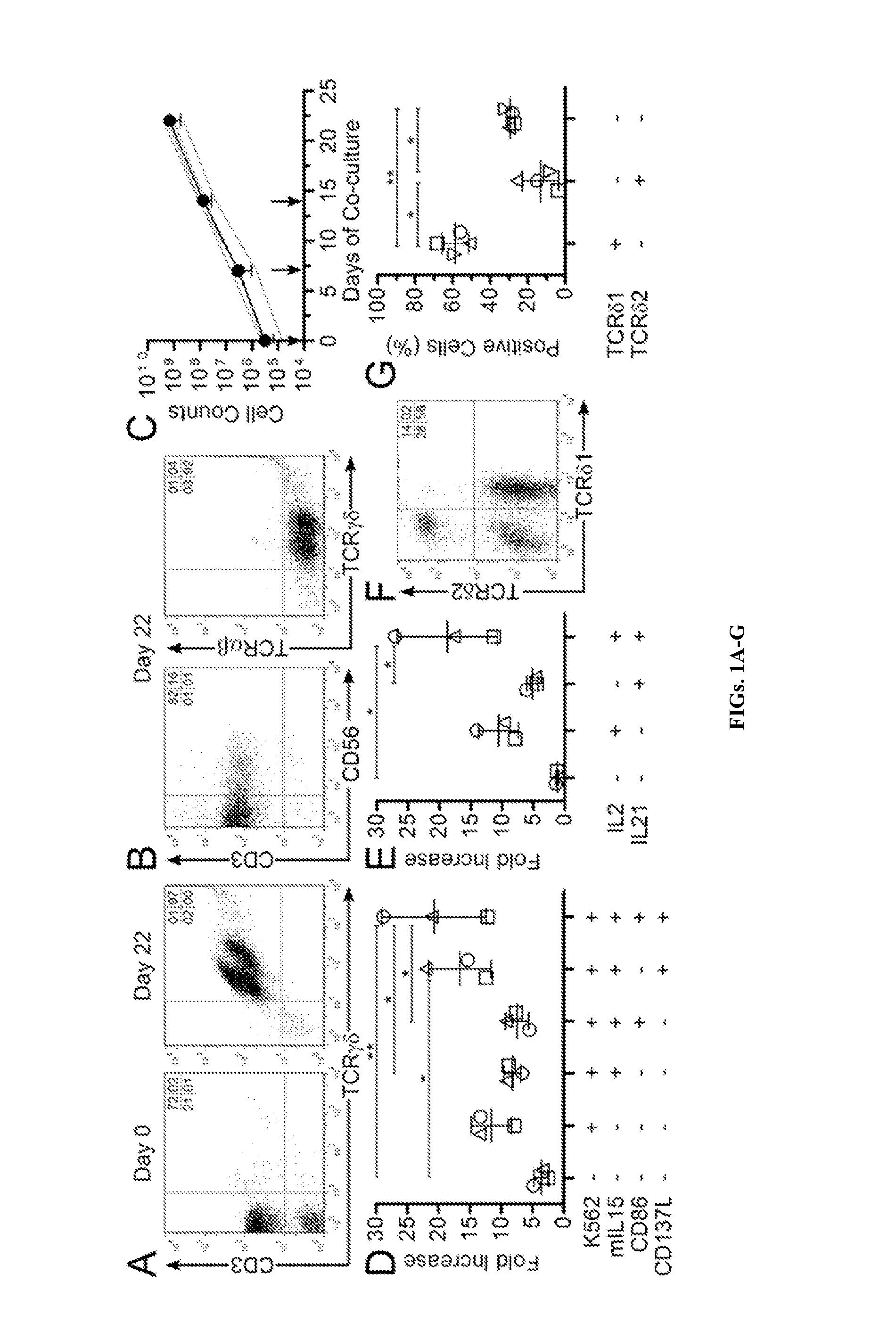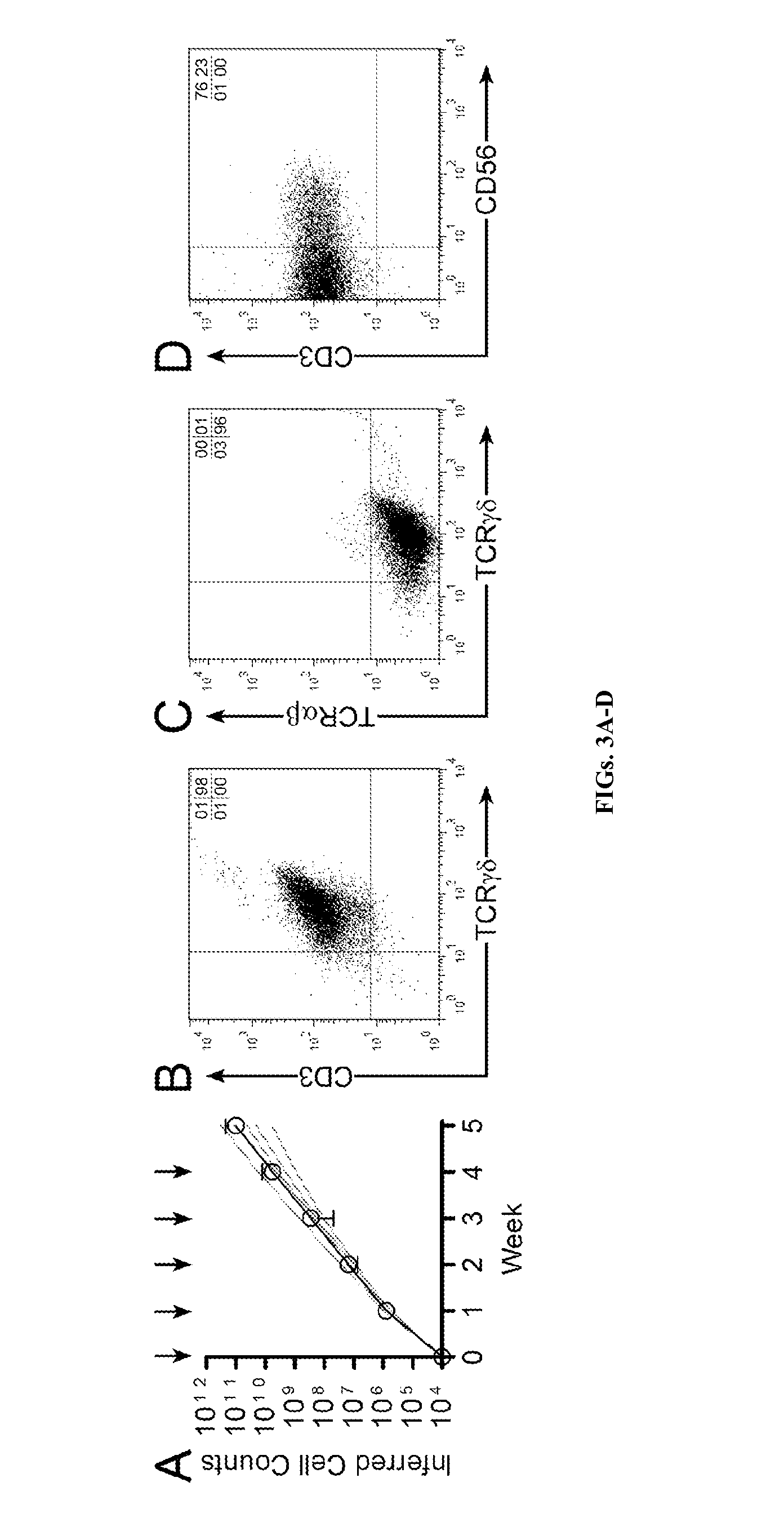Polyclonal gamma delta t cells for immunotherapy
- Summary
- Abstract
- Description
- Claims
- Application Information
AI Technical Summary
Benefits of technology
Problems solved by technology
Method used
Image
Examples
example 1
Subsets of γδ T Cells for Cancer Immunotherapy
[0118]Given that γδ T cells have endogenous anti-cancer activity, such as against K562 cells (D'Asaro et al., 2010; Lamb et al., 1999), the inventors tested whether tumor cells would serve a cellular substrate to propagate polyclonal γδ T cells. K562 cells have been genetically modified to function as artificial antigen presenting cells (aAPC) to activate and numerically expand αβ T cells and NK cells ex vivo (Denman et al., 2012; Maus et al., 2002; Numbenjapon et al., 2006; Singh et al., 2013; Suhoski et al., 2007). The inventors determined that γ-irradiated K562-derived aAPC (designated clone #4, genetically modified to co-express CD19, CD64, CD86, CD137L, and a membrane-bound mutein of IL-15; mIL15) in combination with cytokines can sustain the proliferation of polyclonal T cells expressing Vδ1, Vδ2, Vδ3, Vδ5, Vδ7, and Vδ8 with Vγ2, Vγ3, Vγ7, Vγ8, Vγ9, Vγ10, and Vγ11 TCRs. The inventors demonstrate that these subsets differ with respe...
example 2
Materials and Methods
[0140]Cell Lines and Cell Culture.
[0141]HCT-116 (cat #CCL-247), Kasumi-3 (cat #CRL-2725), and K562 (cat #CCL-243) cell lines were acquired from American Type Culture Collection (ATCC; Manassas, Va.). Jurkat (cat #ACC 282) cell line was received from Deutsche Sammlung von Mikroorganismen and Zellkulturen (DSMZ; Germany). K562-were genetically modified to function as aAPC (clone #4) as previously described (Manuri et al., 2010; Singh et al., 2011). B-cell acute lymphoblastic leukemia (B-ALL) cell lines cALL-2 and RCH-ACV cell lines were gifts from Dr. Jeff Tyner (OHSU), pancreatic cancer cell lines (BxPC-3, CaPan-2, MiaPaCa-2, and Su8686) were donated by Dr. Viji Ramachandran (MDACC), and ovarian cancer cell lines (A2780, CAOV3, EFO21, EF027, Hey, IGROV1, OAW42, OC314, OVCAR3, and UPN251) were provided by Dr. Robert C. Bast, Jr. (MDACC). Cell cultures were maintained in (i) RPMI (Gibco, Grand Island N.Y.): K562 parental cells, aAPC clone #4, aAPC clone A6, aAPC cl...
example 3
Discussion
[0159]This study establishes aAPC clone #4 as a cellular platform for the sustained proliferation of multiple populations of γδ T cells that retain broad reactivity against hematologic malignancies and solid tumors. T cells expressing certain Vδ TCR usage have been associated with clinical responses against cancer. For example, Vδ1 T cells have not been directly infused for therapy. The inventors' data establish that these cells could mediate anti-tumor immunity and support the adoptive transfer of Vδ1 T cells for cancer therapy. The inventors' propagated / activated Vδ2 T cells exhibited the highest killing of tumor cells and cytokine production. A role for Vδ1negVδ2neg-T cells in targeting tumors was previously unknown; however, the inventors' results directly show that Vδ1negVδ2neg cells exhibit anti-tumor activity, and this subset could also be of benefit to immunocompromised patients. In aggregate, the data herein lend impetus to adoptive transfer of γδ T cells that mai...
PUM
| Property | Measurement | Unit |
|---|---|---|
| Time | aaaaa | aaaaa |
| Composition | aaaaa | aaaaa |
| Ratio | aaaaa | aaaaa |
Abstract
Description
Claims
Application Information
 Login to View More
Login to View More - R&D
- Intellectual Property
- Life Sciences
- Materials
- Tech Scout
- Unparalleled Data Quality
- Higher Quality Content
- 60% Fewer Hallucinations
Browse by: Latest US Patents, China's latest patents, Technical Efficacy Thesaurus, Application Domain, Technology Topic, Popular Technical Reports.
© 2025 PatSnap. All rights reserved.Legal|Privacy policy|Modern Slavery Act Transparency Statement|Sitemap|About US| Contact US: help@patsnap.com



